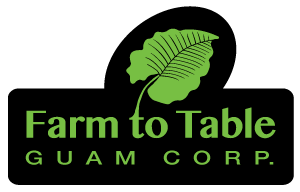
By Chris Leon Guerrero
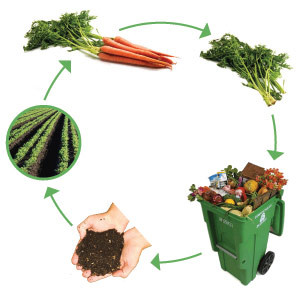 What is Composting Anyway?
What is Composting Anyway?
Composting is a natural process by which nature recycles organic waste— among them tree leaves, grass clippings, fruit peels, and old fruits and veggies. Basically, you’re mimicking what is already going on in forests and jungles around the world. When leaves fall from a tree in the forest, they accumulate on the ground as leaf litter, and with a little moisture and oxygen, the naturally occurring bacteria and fungus turn it into humus. The humus which accumulates on the forest floor is full of nutrients and minerals from the composted leaves, fruit, flowers, and tree branches, and is used up by the tree again and again, each time building the fertility of the forest soils. In your home, this same composting process turns your various household kitchen waste products into a nutrient rich material that can be readily used by your plants.
Benefits of Composting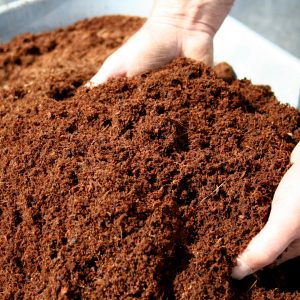
The benefits of composting include:
- Reduced waste inputs into the island’s landfill
- Source of homemade fertilizer
- Increased soil fertility
- Increased drought and pest resistance in plants
- Sense of accomplishment and well-being with nature.
At the end of the composting process, you will be left with a valuable soil additive which you can add to your vegetable garden soils or place around your favorite flowering plant to help it grow. Composting can be a very intimidating process, but just remember that if you stick to four basic requirements, you will have a greater degree of success, rather than failure.
Four Basic Requirements
Nitrogen, Carbon, Water , and Air make up the basic elements of a successful compost bin but what makes the entire process happen are the microorganisms within the compost pile.
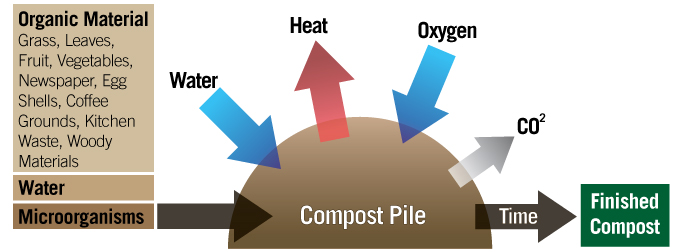
The nitrogen in a compost pile can be sourced from your yard and from the kitchen scraps you save from your daily cooking activities which include:
- Freshly mowed grass clippings
- Vegetable leaves and stems
- Fruit skins
- Peels and cores
- Onion skins
- Old or rotted fruits and vegetables
- Coffee grounds
- Tea bags
- Old rice
- Stale bread
Carbon sources commonly found around the house are:
- Coconut husks
- Hair clippings
- Sawdust
- Wood chips
- Dry mowed grass
- Tree leaves
- Small twigs and branches
- Shredded newspapers
- Plain cardboard
- Egg cartons
- Paper bags
In general, the ratio of these two elements are about 2 ~ 3 parts carbon to 1 part of nitrogen.
The microorganisms are what break down the natural materials in your pile and turn it into a humus rich substance, which also happens to be a good soil builder and additive. Microorganisms in a healthy compost pile are made up of certain bacteria and fungus, some of which occur naturally, and others which may be introduced by adding some of your native soils into the compost pile. The bacteria and fungus need a certain amount of moisture and oxygen in order to be most effective.
Too much moisture and not enough oxygen are common mistakes, with a smelly, soggy pile of rotted organic waste being the result.
To gauge for proper moisture levels, ensure your compost pile is adequately damp– basically something similar to a wrung-out sponge. Too much water and not enough oxygen will turn the heap anaerobic; turning your pile into an inhospitable place for the beneficial bacteria and fungus you are trying to propagate in your compost pile. A lack of moisture will also prevent microorganisms from completing the composting process.
Six Steps to a Thriving Compost Pile

In order to start your personal composting program, decide what type of method of composting is best for your situation. A homeowner with yard space may choose to have a large, open compost pile, while an apartment dweller may choose to purchase a composting bucket fitted for a small balcony. Once you’ve decided your space parameters, individual requirements, and composting methodology, you’re well on your way to obtaining the many benefits of having a home composting program. The next 6 steps will help you launch your program.
- Choose the method of composting most appropriate for your individual conditions and specifications, then buy the appropriate materials. Common examples are composting bins, shovels, gloves, sealed containers, buckets, etc.
- Save all the kitchen scraps you wish to add into your compost pile (Nitrogen source). You may add them to the compost pile as you produce them, or store them conveniently in a sealed container until you decided to dispose of it at a later date. To avoid any unpleasant smells in your home, you may also freeze your kitchen scraps in sealed containers until you do decide to add it to the compost pile.
- Gather yard debris, tree leaves, small twigs, shredded coconut husks, dry grass clippings, shredded newspapers, wood chips, and other such Carbon sources you wish to use in your composting program.
- Mix all four basic elements of composting together and add the mix into your compost bin or pile (Nitrogen, Carbon, Water, and Oxygen).
- Inoculate your mixture with additional microorganisms. A handful of native soils or animal manures, such that from cows or chickens will do
- Maintain the ideal conditions in equilibrium within your compost heap in order to facilitate microorganism growth and proliferation.
Reducing Odor

To reduce excessive smells, risks of contamination, and cut down on insects, do not include the following:
- Meat
- Fat trimmings
- Oils
- Bones
- Animal skin trimmings
- Diseased plants
- Insect infested materials
- Chemicals
- Plastics
- Inorganic materials
*Poke holes in, or turn over the compost heap every so often in order to introduce oxygen back into the interior and bottom of the pile and ensure adequate drainage is allowed if composting in a closed container.
Tips to Increase Your Composting Success Rates
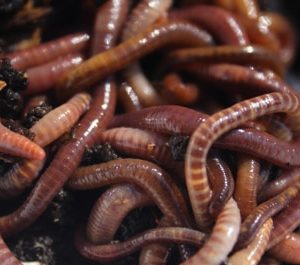
- Maintain proper levels of moisture and oxygen flow throughout the pile
- Follow ideal Carbon to Nitrogen ratios of about 2 ~ 3 parts Carbon to 1 part Nitrogen (2~3:1)
- Do not let your compost pile dry out
- Use rain water for moisture, or if using tap water, allow the chlorine to evaporate by letting it sit for a few hours or even overnight.
- Chop or shred bulky items and materials into smaller pieces to help the microorganisms break it down faster
- Do not add animal products such as dairy, meats, bones, fat, skin trimmings, and oils.
- Do not add carnivorous (meat eating) pet droppings, diseased plants, insect pests, or any contaminated materials into the pile
- Incorporate as much varied organic materials as possible in order to make a more comprehensive mineral and nutrient dense final product
- The bigger the compost heap, the better
- The rate of composting will increase if you incorporate certain species of earthworms (such as “red wigglers”- Eisenia fetida) in your pile
In a few short months and with some help from beneficial microorganisms, you will have a dark, humus-rich substance that is full of minerals and nutrients which your vegetables and favorite flowering plants will appreciate. The final product is alive with healthy, soil building properties that are beneficial to plants, mankind, our environment, and our island.
[nivoslider id=”1033″]Photo Sources: fertilefibre.com, en.paperbolg.com, tuesdayswithlaurie.com, blueskiesrecycling.com, trishjoseph.com, askmissa.com
